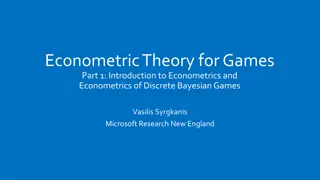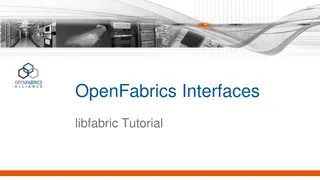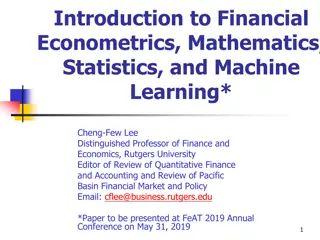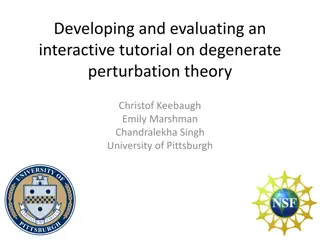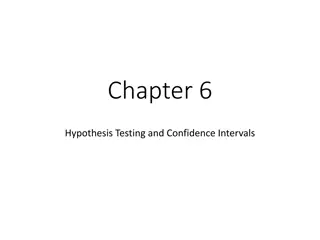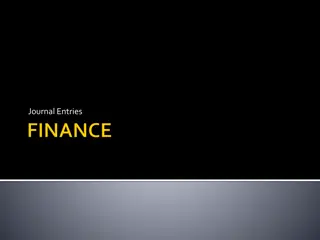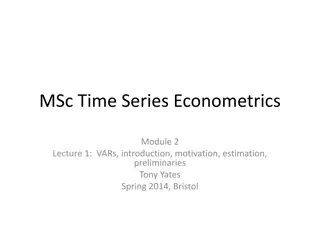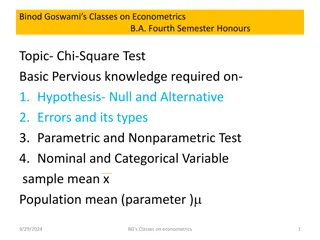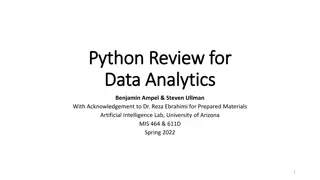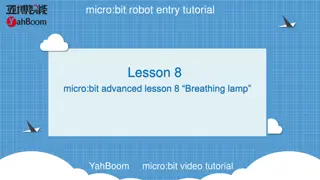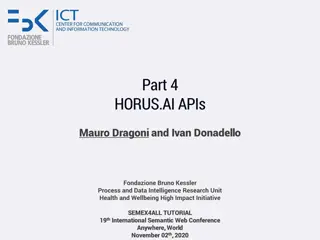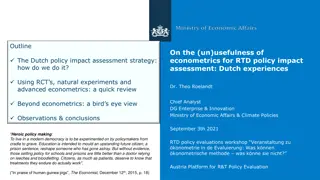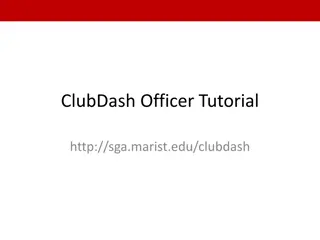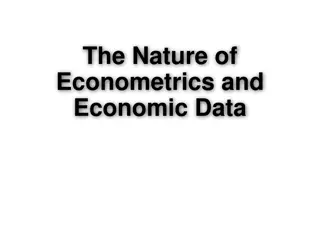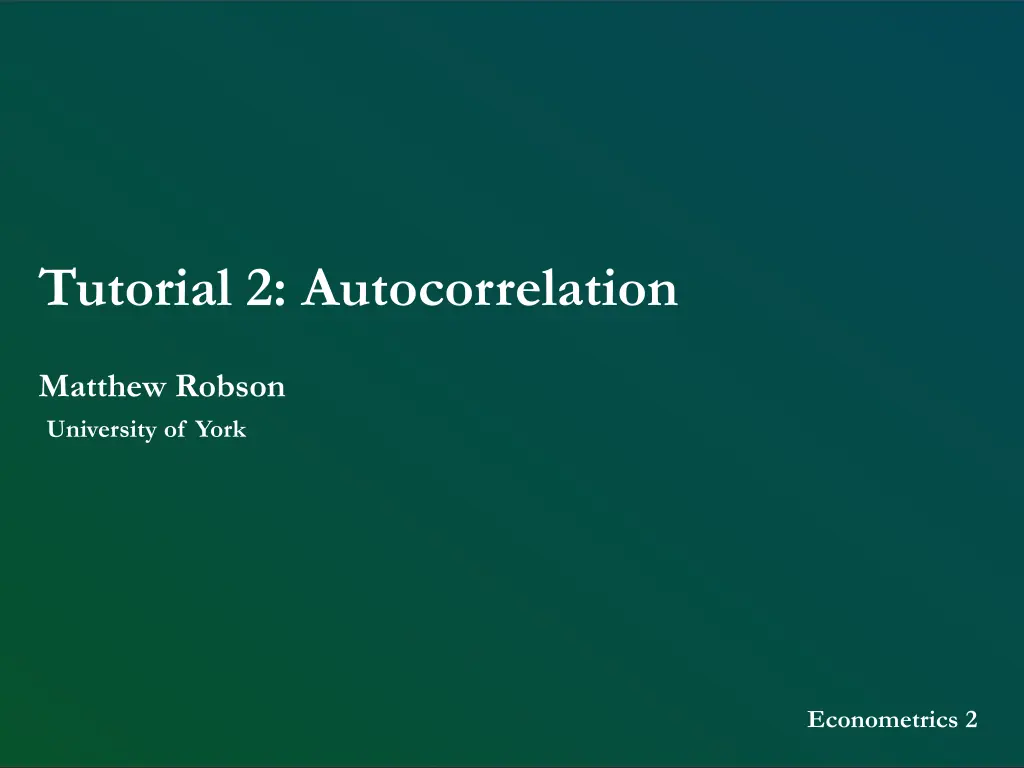
Econometrics Tutorial on Autocorrelation Analysis and Testing Models
Explore the concept of autocorrelation, test models, and apply Durbin-Watson and Breusch-Godfrey tests in econometrics. Understand limitations and implications for data analysis.
Download Presentation

Please find below an Image/Link to download the presentation.
The content on the website is provided AS IS for your information and personal use only. It may not be sold, licensed, or shared on other websites without obtaining consent from the author. If you encounter any issues during the download, it is possible that the publisher has removed the file from their server.
You are allowed to download the files provided on this website for personal or commercial use, subject to the condition that they are used lawfully. All files are the property of their respective owners.
The content on the website is provided AS IS for your information and personal use only. It may not be sold, licensed, or shared on other websites without obtaining consent from the author.
E N D
Presentation Transcript
Tutorial 2: Autocorrelation Matthew Robson University of York Econometrics 2 1
Autocorrelation Autocorrelation emerges when the errors in different time-periods are correlated. When ??? ??,?? 0, ? ? (a) Positive Autocorrelation (b) Negative Autocorrelation (Gujarati and Porter, 2009) 2
Assignment 7 Estimate the log-linear consumption function: (1) ??? ?? = ?0+ ?1??? ?? + ?2??? ?? + ?4??+ ?? Where: ??= consumption, ?? = real disposable income ??= wealth, ??= interest rate For the period 1967q1 2002q4. 3
Results ??? ?? = 0.8559 + 0.9165 ??? ?? + 0.0138 ??? ?? + 0.0022??+ ?? 5
Question a) Test for autocorrelation using the Durbin-Watson test statistic given by PC-GIVE. What are the limitations of this test? How does the Breusch-Godfrey test overcome some of these limitations? 8
Durbin-Watson Test Defined as: ?=? ?? ?? 1 ?=1 2 ? = ?=2 2 ?=? ?? 9
Durbin-Watson Test ????? ???? ???? ???????? ????????????????,??????????? ??? ?? Durbin-Watson Statistic: ? = 0.439 ? = 144,? = 3 ? = 0.05 ??= 1.774,??= 1.693 ? = 0.01 ??= 1.665,??= 1.584 ?0: no +ve autocorrelation, ?0 The ? statistic is less than the critical ?? value we reject the null hypothesis (?0) of no +ve correlation at both 5% and 1% levels. : no -ve autocorrelation 10
Question a) Limitations of Durbin-Watson statistic 1. Lagged residuals only to first order 2. Zones of indecision 3. Not appropriate when lagged dependant variable is included The Breusch-Godfrey test allows: 1. Higher order autocorrelation 2. Still appropriate when a lagged dependant variable is included 11
Question b) Test for autocorrelation using the Breusch-Godfrey test statistic given by PC-GIVE. What (default) order of autocorrelation is being tested for here? 12
Question b) ????? ???? ???? ????? ??????????????? ???? The order of the autocorrelation being tested here is 5th, e.g ??= ?1?? 1+ ?2?? 2+ ?3?? 3+ ?4?? 4+ ?5?? 5+ ?? 2 2 0.05= 11.0705,?5 2 0.01= 15.0863 Test statistic is 97.171~?5 We reject ?0 (of no autocorrelation) at both 5% and 1% levels. ?5 13
Question c) Construct the Breusch-Godfrey test for up to second order autocorrelation and test using the F statistic. 14
Breusch-Godfrey Test Method 1. Estimate the model and save the residuals ( ??) Estimate: ??= ?0+ ?1log ?? + ?2log ?? + ?3??+ ?4 ?? 1+ ?5 ?? 2+ ?? Note the ?2 from Step 2 and calculate the ?2 test statistic as: ? ? ?2~?? Where: ? = ???? ??.?? ???????????? ? = ?????? ?? ???? (?? ? ? ????? ?? ???????????????) 2. 3. 2 Compare the test statistic from Step 3 with the ?2 critical values at the 5% and 10% levels. 4. 15
Breusch-Godfrey Test Construct the Breusch-Godfrey test, for second order autocorrelation, e.g. ?? = ?0+ ?1log ?? + ?2log ?? + ?3?? + ?4 ?? 1+ ?5 ?? 2+ ?? ??= ?1?? 1+ ?2?? 2 ?0: ?? ???????????????,?1= ?2= 0 ?1: ?0 ?? ????? Test Statistic: ? ? ?2= 44 2 0.669224 95.0298~?2 2 2 0.05= 5.991 2 0.01= 9.210 ?2 ?2 We reject the null hypothesis of no autocorrelation at both 5% and 1% 16
Breusch-Godfrey Test (F-test) Method 1. Estimate the model and save the residuals ( ??) Estimate two factor models: 2. RES: ??= ?0+ ?1log ?? + ?2log ?? + ?3??+ ?? UNRES: ??= ?0+ ?1log ?? + ?2log ?? + ?3??+ ?4 ?? 1+ ?5 ?? 2+ ?? Over the same sample i.e. ? 2 = ? ? = 144 2 3. Undertake the F-test for: ?0:?4= ?5= 0 2 2 ?????? 1 ?????? ???? ? ? = 2 ? ? Where: ? = ??.?? ???????????? ? = ??.?? ?????????? ?? ????? ? = ??.?? ???????????? ?? ? ? ????? ?????? (? ?) 17
Breusch-Godfrey Test (F-test) ???: ??= ?0+ ?1log ?? + ?2log ?? + ?3??+ ?? Construct the Breusch-Godfrey test, for second order autocorrelation. ?0: ?? ???????????????,?4= ?5= 0 ?1: ?0 ?? ????? Test Statistic: 2 2 ?????? 1 ?????? ???? ? ? = 2 ? ? ?????: ?? = ?0+ ?1log ?? + ?2log ?? + ?3??+ ?4 ?? 1+ ?5 ?? 2 + ?? 0.669224 7.266996 10 6 1 0.669224 2 ? = 142 6 ? = 137.57567~??,? ? 0.05 3.07, 0.01 4.79 ?2,136 ?2,136 We reject the null hypothesis of no autocorrelation at both 5% and 1% 18
Question c) ????? ???? ???? ????? ??????????????? ???? ( ?? ??? = 2) Test Statistic: 2 96.262 ~?2 2 0.05= 5.991 2 0.01= 9.210 ?2 ?2 We reject the null hypothesis of no autocorrelation at both 5% and 1% 19
Question d) What are the consequences of your findings for the usefulness of the standard Ordinary Least Squares results for the consumption function above? 20
Question d) Consequences of autocorrelation 1. 2. 3. 4. OLS estimators are LUE but not BLUE (most efficient and unbiased) The estimated variances of OLS estimators are biased Usual ?and ? tests are unreliable The usual formula to compute the error variance is a biased estimator of the true ?2 The conventionally computed ?2 may be an unreliable measure of the true ?2 5. 21

